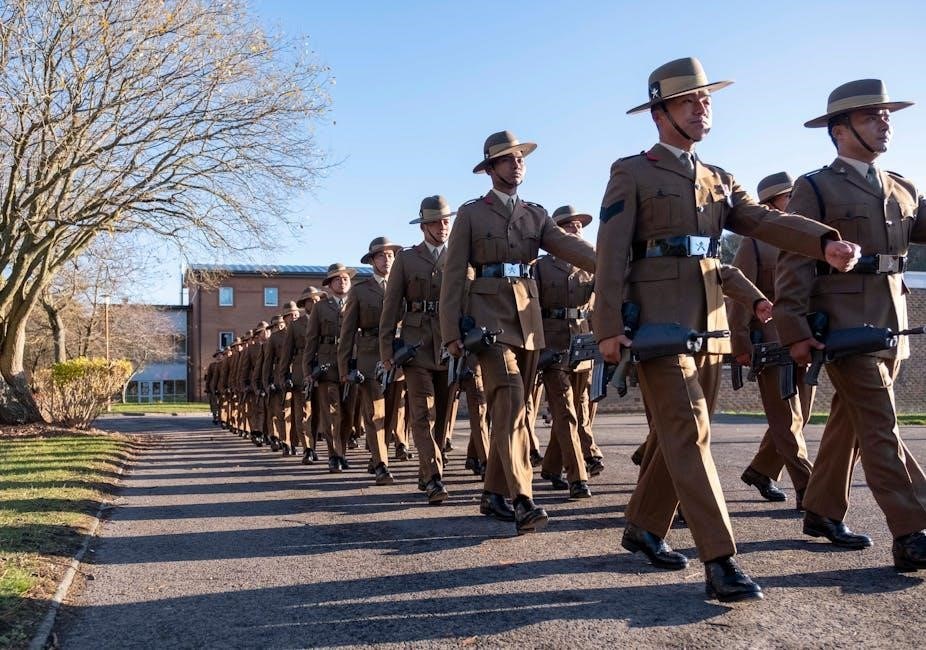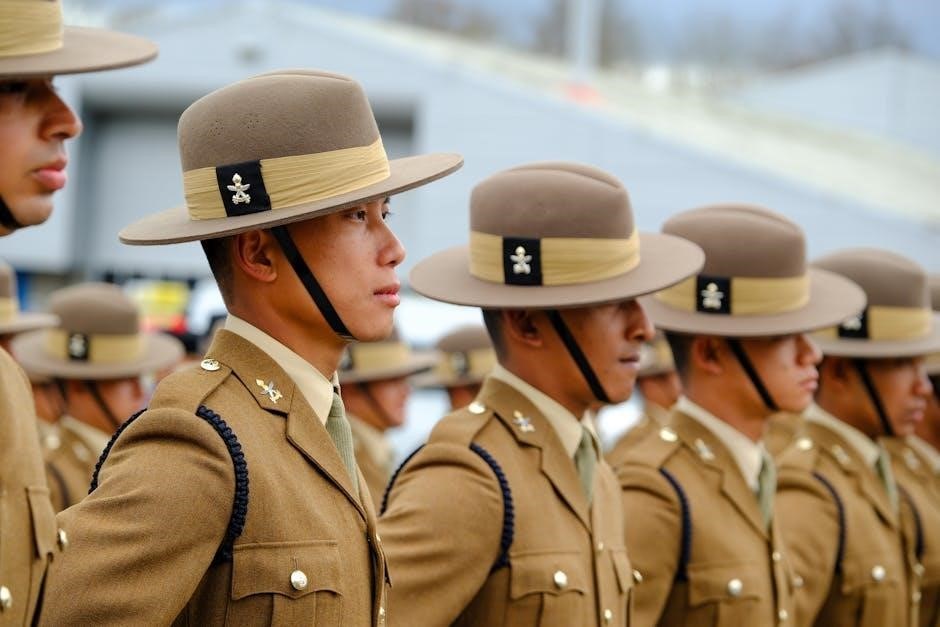Offensive line drills are essential for building a strong, cohesive unit, focusing on technique, strength, and coordination. These drills enhance run blocking, pass protection, and overall execution, ensuring linemen dominate the line of scrimmage while maintaining proper form and discipline.
1.1 Importance of Offensive Line Drills in Football
Offensive line drills are the cornerstone of a successful football team, as they directly impact the execution of both run and pass plays. These drills foster physical strength, mental toughness, and technical proficiency, enabling linemen to dominate at the line of scrimmage. By mastering proper blocking techniques, footwork, and hand placement, offensive linemen ensure the protection of the quarterback and create openings for running backs. Consistency and coordination among the line are critical, as they dictate the flow of the game; Investing time in these drills builds a formidable unit capable of controlling the trenches, which is essential for any offensive strategy to thrive.
1.2 Overview of Key Drills for Offensive Linemen
Key offensive line drills focus on fundamental skills like blocking, footwork, and strength. Drills such as the drive block and zone blocking enhance run game effectiveness, while pass protection drills like the quick set and hand striking improve quarterback safety. Footwork exercises, including ladder drills and side-to-side movements, develop agility and quickness. Strength-building drills, such as medicine ball throws and leverage exercises, boost power and explosiveness. Combination blocks and double teams emphasize teamwork and coordination. These drills collectively prepare linemen for game situations, ensuring they can execute assignments with precision and consistency, ultimately contributing to the team’s success on the field.

Run Blocking Drills
Run blocking drills focus on clearing running lanes and moving defenders. Techniques include drive blocks, zone blocking, and double teams, emphasizing coordination, power, and proper footwork to dominate the line.
2.1 Drive Block: Basic One-on-One Blocking Technique
The drive block is a fundamental one-on-one blocking technique used to clear a path for the running back. The offensive lineman starts with a 6-8 inch power step outside the defender’s base, driving their feet and exploding forward. Proper footwork and hand placement are critical, with hands inside the defender’s torso to maintain control. Coaches emphasize staying low, leveraging hips, and driving through the block to create movement. This drill teaches linemen to dominate defenders individually, building confidence and physicality. Consistent practice ensures proper form and explosive power, making the drive block a cornerstone of effective run blocking in football.
2.2 Zone Blocking: Working Together to Clear Running Lanes
Zone blocking is a technique where offensive linemen work together to clear running lanes by blocking multiple defenders in a coordinated effort. Each lineman is responsible for a specific zone, focusing on maintaining blocks and creating seams for the running back. The drill emphasizes proper footwork, hand placement, and communication to ensure a cohesive unit. Linemen must stay low, use their hips to generate power, and adjust their blocking angles based on defensive alignment. This technique requires precision and teamwork, as each player’s role contributes to the overall success of the play. Regular practice helps build chemistry and ensures linemen can adapt to different defensive looks while maintaining their assigned zones.
2.3 Double Team Blocks: Combining Efforts to Move Defenders
Double team blocks involve two offensive linemen working together to move a single defender, creating a clear path for the ball carrier. This technique is crucial in both run and pass situations, requiring precise communication and timing. The linemen must synchronize their steps, ensuring one delivers the initial blow while the other secures the block. Drills focus on proper hand placement, footwork, and leveraging combined strength to drive defenders off the line. Effective double teaming builds a dominant running game and protects the quarterback in passing situations, showcasing the power of teamwork in the trenches. Regular practice reinforces these skills, making it a cornerstone of offensive line strategy.

Pass Protection Drills
Pass protection drills focus on securing the quarterback by blocking rushers. Techniques include quick sets, hand placement, and maintaining balance. Drills like Pass Pro Quick Set and React to Pass Rush enhance reaction speed and proper form, ensuring linemen can neutralize pressure effectively while keeping the pocket clean for the quarterback to operate.
3.1 Base Pass Blocking: Maintaining Proper Form and Footwork
Base pass blocking is the foundation of pass protection, emphasizing proper form and footwork. Linemen start in a balanced stance, feet shoulder-width apart, knees bent, and weight slightly forward. Upon the snap, they explode out of their stance, making contact with the rusher while keeping hands inside and elbows close to the body. Footwork drills, such as the shuffle and kick-slide, are crucial for maintaining balance and mirroring the defender’s movements. Coaches stress the importance of staying low, engaging with the chest plate, and driving through the block to create a stable pocket for the quarterback. Consistent practice of these techniques ensures effective pass protection.
3.2 Pass Pro Quick Set: Reacting to Pass Rushers
The Pass Pro Quick Set is a critical drill for offensive linemen to master, focusing on rapid reaction to pass rushers. Linemen start in a 3-point stance, exploding forward on the snap. They must quickly identify the rusher’s angle and adjust their footwork accordingly. Drills like the “Duct Demeanor” and “Towel Punch” enhance hand placement and balance, while the “Kick Slide & Punch” improves lateral movement and striking technique. Coaches emphasize staying low, maintaining a wide base, and delivering a punch with hands inside. This drill simulates game scenarios, teaching linemen to mirror defenders and protect the pocket effectively. Proper execution ensures the quarterback has time to throw, making the Pass Pro Quick Set indispensable for pass protection success.

Combination Blocks and Double Teams
Combination blocks and double teams are advanced techniques where linemen work together to clear defenders. They emphasize coordination, timing, and teamwork to dominate at the point of attack.

4.1 Coaching Points for Effective Combination Blocks
Coaching combination blocks requires emphasizing coordination, communication, and timing among linemen. Start with proper alignment and stance, ensuring each player understands their role. Teach the first lineman to deliver a solid initial contact, while the second provides lateral support. Focus on maintaining a tight seal and driving legs to move the defender. Stress the importance of sustaining the block until the play develops. Use drills like the double-team fit drill to practice synchronization. Ensure linemen keep their hands inside and maintain balance to avoid penalties. Emphasize finishing the block by driving the defender backward. Incorporate circuit drills to simulate game scenarios and build teamwork; Consistent repetition and feedback are key to mastering combination blocks effectively.

Footwork and Agility Drills
Footwork and agility drills enhance offensive linemen’s quickness, balance, and coordination. Techniques like ladder drills, cone exercises, and mirror dodge drills improve speed and reaction time, essential for blocking effectively.
5.1 Side-to-Side Footwork: Developing Quick Feet

Side-to-side footwork drills are crucial for offensive linemen, focusing on quick lateral movements. These exercises, often conducted using cones or ladders, improve agility and reaction time. Players are instructed to maintain proper stance and balance while rapidly shifting their feet. The goal is to enhance their ability to mirror defenders and maintain positioning during blocks. Coaches emphasize staying low, keeping knees bent, and driving with the legs. These drills also help linemen develop the ability to adjust to different angles and pressures, ensuring they can effectively protect the quarterback or clear paths for runners in dynamic game situations.
5.2 Ladder Drills: Enhancing Agility and Speed
Ladder drills are a fundamental tool for improving offensive linemen’s agility, speed, and footwork precision. By placing a ladder on the ground, players perform various footwork patterns, such as high knees, lateral shuffles, and carioca drills. These exercises enhance quickness, coordination, and reaction time, essential for mirroring defenders and maintaining balance. Coaches often incorporate variations, such as changing directions or adding resistance, to simulate game-like movements. The drills also focus on proper foot placement and explosive acceleration, helping linemen develop the agility needed to excel in both run and pass blocking scenarios. Consistent practice with ladder drills ensures offensive linemen can move efficiently and effectively on the field.

Strength and Conditioning Drills
Strength and conditioning drills are crucial for offensive linemen, focusing on building explosive power, core stability, and upper body strength through medicine ball throws and leverage exercises.
6.1 Medicine Ball Drills: Building Explosive Power
Medicine ball drills are integral to enhancing offensive linemen’s explosive power. Starting from a 3-point stance, players thrust the ball forward with both hands, emphasizing rapid, forceful extensions. This motion mimics blocking explosiveness, improving core strength and arm power. Variations include side tosses and overhead throws, targeting different muscle groups. Coaches emphasize proper technique to maximize power output and minimize injury risk. These drills not only build strength but also improve reaction time and coordination, essential for dominating at the line of scrimmage. Consistent practice ensures linemen can deliver impactful blocks consistently during games.
6.2 Leverage Drills: Strengthening Core and Upper Body
Leverage drills are designed to strengthen the core and upper body, crucial for offensive linemen to maintain control and generate power. These exercises often involve partners working together, with one applying resistance while the other resists, focusing on maintaining proper hand placement and balance. By engaging the core and using leg drive, linemen improve their ability to anchor against defenders and sustain blocks. Coaches emphasize keeping a low center of gravity and driving through the hips to maximize effectiveness. These drills not only build physical strength but also enhance technique, ensuring linemen can maintain leverage and control in game situations.

Finishing the Block
Finishing the block requires linemen to maintain contact and drive defenders until the whistle blows, ensuring the play isn’t stopped early. This emphasizes effort, discipline, and technique.
7.1 Emphasizing the Importance of Playing to the Whistle
Playing to the whistle is crucial for offensive linemen, as it ensures they maintain effort and contact until the play concludes. This prevents early stoppage and maximizes the offensive gain. Coaches often stress the importance of finishing blocks, even when the ball carrier is down, to avoid penalties and maintain momentum. Drills like the “Finish Drill” or “Whistle-to-Whistle” exercises simulate game scenarios, teaching linemen to stay engaged until the whistle blows. This mindset builds discipline and underscores the team’s commitment to excellence in every play; Proper technique and persistence are key to mastering this fundamental aspect of offensive line performance.
